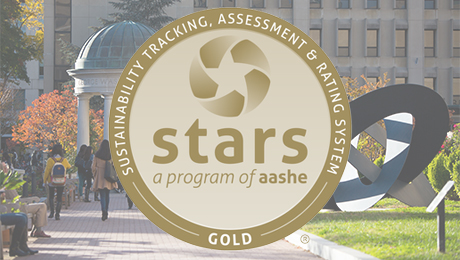From seven LEED Gold-certified design projects, an on-campus farmers market that accepts GWorld and a commitment to the Real Food Challenge to the creation of “green leaf” courses, a Solar Institute and the Urban Food Task Force, the George Washington University has adopted a comprehensive approach to building a sustainable campus community.
“Many people think of sustainability as just environmental, but at GW we believe in creating resource systems that are healthy and thriving for all, which means focusing on social equity and human resources as well,” Director of the Office of Sustainability Meghan Chapple said.
To share these efforts, the university has provided a comprehensive look at sustainability on campus through the Association for the Advancement of Sustainability in Higher Education’s (AASHE) Sustainability and Tracking Assessment and Rating System (STARS), a voluntary reporting database.
Recently, GW joined 62 universities nationwide in earning a gold rating through the STARS system.
“We have robust and comprehensive plans for implementing sustainable initiatives at GW,” Ms. Chapple said. “The purpose of the STARS report is to provide an in-depth look at GW’s sustainability practices, create a dialogue around our efforts, highlight our success and motivate discussion for ways to improve.”
In a letter posted on the STARS website, George Washington President Steven Knapp reaffirmed the university’s vision, writing that GW has a “mandate of encouraging sustainability locally, nationally and globally” that will be fulfilled in the coming years.
GW’s academic programming focused on sustainability received high marks in the report. The university boasts faculty research and 200 courses related to sustainability in all 10 schools.
One hundred undergraduate courses have been designated “green leaf” courses, which are linked to the university-wide sustainability minor that launched in 2012. To date 140 students have declared a sustainability minor.
Associate Professor Lisa Benton-Short said that the interdisciplinary nature of sustainability encourages students and faculty across the university to get involved, from service programs such as the GWupstart social entrepreneurship program in the Center for Civic Engagement and Public Service to the academic Sustainable Landscapes program in the College of Professional Studies and the media-focused Planet Forward program in the Center for Innovative Media at the School of Media and Public Affairs.
GW’s interdisciplinary approach is exemplified in Sustainability 1001, the introductory course to the sustainability minor, which provides an overview of sustainability in action. The course is team-taught by five faculty members representing CPS, CCAS, the Law School, the Milken Institute School of Public Health and the School of Engineering and Applied Science.
“Through our academic programming, undergraduate and graduate students from all 10 schools are beginning to see how sustainability can complement a range of majors and minors,” Dr. Benton-Short said. “Ultimately, discussions around sustainability center on the fact that there is no one magic bullet to solve these issues. We need students with diverse skill sets.”
GW was also recognized for a commitment to innovation, defined by AASHE as “new, extraordinary, unique, ground‐breaking, or uncommon outcomes, policies, and practices.”
Among the innovations recognized by AASHE was a 2012 partnership with OPower, a software-as-service company that engaged faculty and staff to reduce their energy use at home for the GW Energy Challenge and the Graduate School of Education and Human Development’s Community-Engaged Teaching program which prepared graduate teaching interns to work in the community through a partnership with Groundwork Anacostia River D.C.
“This report is the beginning of an inventory of what GW does well as a university committed to sustainability,” Dr. Benton-Short said. “It is also a blueprint as we move forward and make a new set of deeper and richer goals.”


